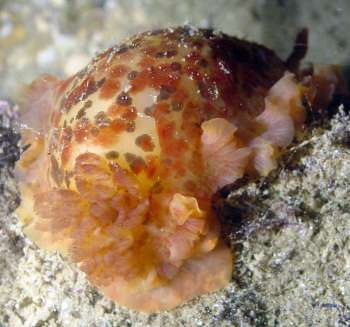
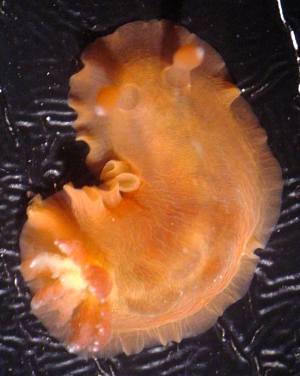
Dendrodoris senegalensis
Bouchet, 1975
Order: NUDIBRANCHIA
Suborder: DORIDINA
Superfamily: EUDORIDOIDEA
Family: Dendrodorididae
PHOTO
Dakar [Site: Terou baye Sogui], Senegal, Eastern Atlantic.
Upper: Depth: 2m. June 02, 2003. Size: 75-80mm. Lower: Depth: 4m. May 30, 2003. Size: 15mm. Photos: Marina Poddubetskaia
Originally described from Senegal it has also been reported from the Cape Verde Ids. In adults, the background colour of the mantle is very variable, ranging from translucent white, yellow, orange, brown, or grey. Scattered all over are diffuse spots of varying size, ranging in colour from light and dark brown to red. Juveniles are invariably translucent orange-red, and as they grow a pattern of darker spots begins to develop. The gills and rhinophores are similar in colour to the mantle and have a whitish tip. The gills are relatively large. D. senegalensis grows to at least 80mm in length.
This species is compared with other species described from West Africa in a separate message.
See also Marina Poddubetskaia Ossokine's message [#17131] discussing similarity of Dendrodoris grandiflora to D. senegalensis.
References:
• Bouchet, P. (1975) Nudibranches nouveaux des cotes du Senegal. Vie et Milieu, 25(1): 119-132
• Valdes, A., Ortea, J., Avila, C. & Ballesteros, M. (1996) Review of the genus Dendrodoris Ehrenberg, 1831 (Gastropoda: Nudibranchia) in the Atlantic Ocean. Journal of Molluscan Studies, 62: 1-31.
Rudman, W.B., 2003 (July 3) Dendrodoris senegalensis Bouchet, 1975. [In] Sea Slug Forum. Australian Museum, Sydney. Available from http://www.seaslugforum.net/find/dendsene
Related messages
Re: Dendrodoris grandiflora from southern Portugal
July 14, 2006
From: Marina Poddubetskaia Ossokine
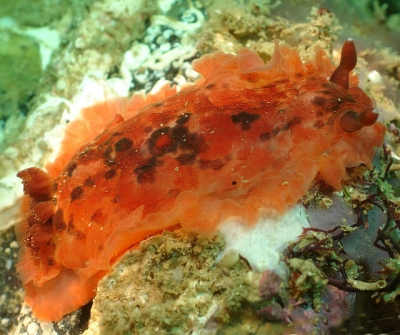
Concerning message #17106:
Dear Carlos and Bill,
The red animal surprised me because I have an almost identical photo but from Senegal, identified for now as Dendrodoris senegalensis. As you can see in attached here photos, there isn't any external difference and even the mantle border is similar, with the pattern of branching lines present in both animals.
Locality: 'Cap Manuel', Dakar, 4m, Senegal , Atlantic Ocean, 2 June 2005 . Length: 55mm. Photographer: Marina Poddubetskaia Ossokine.
So, I'm wondering if Dendrodoris senegalensis could be a junior synonym of Dendrodoris grandiflora? Moreover, I have already found black D. senegalensis and uniform red juveniles. And when I wrote my first messages to the Forum about the Senegalese Dendrodoris I noted their similarity to D. grandiflora.
Bill, please could you give your opinion on these species.
Best wishes,
Marina.
Nembro website
nembro@nembro.info
Poddubetskaia Ossokine, M. , 2006 (Jul 14) Re: Dendrodoris grandiflora from southern Portugal. [Message in] Sea Slug Forum. Australian Museum, Sydney. Available from http://www.seaslugforum.net/find/17131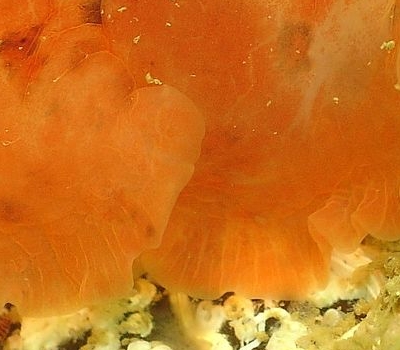
Dear Marina,
I agree with your puzzlement. All I can go on is the latest comprehensive study (Valdes, et al, 1996) which reviewed the Atlantic species. Angel Valdes comments on the northeastern species in an earlier message [#2461] but does not include a discussion about 'lookalikes' of D. grandiflora. That study gives the distribution of D. grandiflora as the Mediterranean and the Atlantic coast from Portugal south to Mauritania, and out to the Canary Islands. D. senegalensis, they say, is only known from Senegal.
My feeling is that some European workers still have a fairly eurocentric view of the world. Where as I would feel quite comfortable with a species extending from southern Europe down the west coast of Africa, they are more comfortable with a European species and a few similar but distinct species from surrounding regions. Defining species of Dendrodoris is difficult because one of the main characters we use in other dorid families - the radula - is absent. Valdes et. al. consider the shape of the spines on the penis to be a useful character in separating species of Dendrodoris but I must say I am less sure of their usefulness. They consider these two species can be separated on spine shape, D. grandiflora having a large base and D. senegalensis having a narrow base. However there is so much variation in spine shape and base size in the spines of just one penis of one species, that I find this a very shaky character on which to separate species.
We have similar problems with the Indo-West Pacific species D. nigra and D. fumata, where there is considerable colour variability within the species, and colour similarity between species. And like the Atlantic species, they start as red juveniles and change to their adult colour pattern as they develop. I suspect we will have to wait until DNA testing is sophisticated enough to give us unambiguous answers, but at present I think we should continue to build up observations on their biology and natural history - what are their eggs and egg ribbons like, what sponges do they feed on etc?
-
Valdes, A., Ortea, J., Avila, C. & Ballesteros, M. (1996) Review of the genus Dendrodoris Ehrenberg, 1831 (Gastropoda: Nudibranchia) in the Atlantic Ocean. Journal of Molluscan Studies, 62: 1-31.
Best wishes,
Bill Rudman
Dendrodoris senegalensis (?) from Senegal
July 7, 2003
From: Marina Poddubetskaia
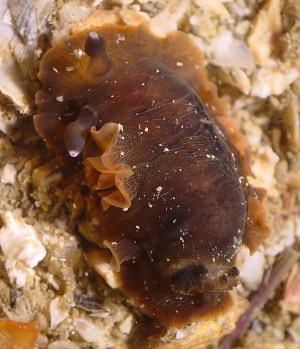
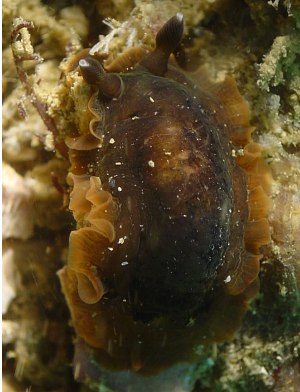
Dear Bill,
Here is another dendrodorid and it looks a little different from previous ones. For this one I'm hesitating between Dendrodoris grandiflora and D. herytra. Unfortunately, I haven't any good shot of its gills and I don't remember if they are short or quite long.
Date: May 30, 2003
Location: Dakar, Senegal, Eastern Atlantic
Site: Terou baye Sogui
Depth: 4m
Size: 25mm
Photos: Marina Poddubetskaia - Nembro website
Best wishes,
Marina.
nembro@nembro.info
Poddubetskaia, M., 2003 (Jul 7) Dendrodoris senegalensis (?) from Senegal. [Message in] Sea Slug Forum. Australian Museum, Sydney. Available from http://www.seaslugforum.net/find/10360Dear Marina,
I think this is one that needs some local knowledge. My first inlination is to think it is a dark colour form of D. senegalensis. As I discuss in my earlier message, this brownish-black mottled form fits the range described by Valdes et al (1996) from Cape Verde Islands.
Best wishes,
Bill Rudman
Dendrodoris senegalensis - juveniles
July 6, 2003
From: Marina Poddubetskaia

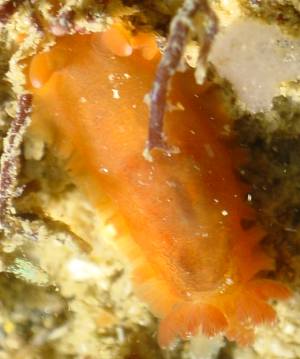
Dear Bill,
Here are some juvenile dendrodorids and I think they belong to the same species as the adult in the previous message. But maybe I'm wrong. I let you sort it out. They are just red, like most juvenile dendrodorids. I remember, all of them had relatively long gills, even if it can't always be seen in photos.
Dakar, Senegal, Eastern Atlantic
Site: Terou baye Sogui., Depth: 4m., 30 May 2003. Size: 15mm. Photos: Marina Poddubetskaia - Nembro website
[See other messages for photos of adults and subadults]
Best wishes,
Marina.
nembro@nembro.info
Poddubetskaia, M., 2003 (Jul 6) Dendrodoris senegalensis - juveniles. [Message in] Sea Slug Forum. Australian Museum, Sydney. Available from http://www.seaslugforum.net/find/10381Dear Marina,
As you suggest, many species of Dendrodoris have red juveniles, including the 3 similarly coloured species from West Africa which I discuss in a separate message. The gills are relatively large, which would rule out Dendrodoris herytra, so I guess D. senegalensis is the most likely identification. In the upper photo there seems to be seens of dark patches developing, and the gills and rhinophores are tipped with white.
Best wishes,
Bill Rudman
Dendrodoris senegalensis
July 6, 2003
From: Bill Rudman
I have identified the Dendrodoris from Senegal in Marina Poddubetskaia's recent messages [juveniles, subadults, adults] as Dendrodoris senegalensis, which as its name implies was originally described from Senegal (Bouchet, 1975).
I have translated Bouchet's description of the external colour to read:
The nine individuals observed alive measured from 7 to 60 mm fully extended. Juveniles from [approx 7 to 20 mm long] are translucent reddish, as are the rhinophores and gills, which have whitish tips. In the older individuals, the mantle is translucent, ranging from pinkish red to brownish yellow, with brown and red marblings. The edge of the mantle is undulating and carries pink radiating lines. The underside of the mantle, and the foot, are a plain translucent greyish colour. Some individuals have more red pigment, which masks the underlying red and brown mottling.
More recently Valdes et al (1996) have reviewed the dendrodorids of the Atlantic and proposed some new species, including two from the West African coast, D. angolensis and D. guineana which both have similarities to Marina Poddubetskaia's animals. In particular, their photo of D. angolensis is almost identical to Marina's photos of adults from Senegal. The only difference is that in D. angolensis the tips of the rhinophores are described as red, while in D. senegalensis they are white, and 'usually' there is a thin red line at the mantle edge. D. guineana does not appear to have any red pigmentation, and the adult mottled colour pattern is described as grey rather than brown.
In their description of D. senegalensis from Cape Verde Island they describe the external morphology as:
"The background colour of the body is very variable, it can be white, yellow, orange, brown, grey or black. Most of the specimens studied have dark grey or black spots on the dorsum. No relationship between size and pigmentation has been observed in adult specimens. The rhinophores and the gills are similar in colour to the body, with the apex (in the rhinophores) and the exterior border (in the gills) white. Juvenile specimens are uniformly red. No spicules were observed. The mantle margin is wide and strongly striated. It is about as wide as ½ the foot"
Absent from this description is any mention of the red patches described by Bouchet and clearly visible in Marina's photos. These three species, especially D. senegalensis and D. angolensis show many external similarities. Some differences between the three species, in the shape and width of ducts in the reproductive system and in the detail of the penial spines are noted. It would be interesting if someone were to examine the anatomy of many more specimens of each of these species to see just how consistent the anatomical differences are. If these three very similar looking species, all living in close geographic proximity, are confirmed to be good species, it would suggest we should look very closely at the 'variable' species we have accepted in the Indo-West Pacific. Perhaps they are clusters of different species. Unfortunately no one has yet shown that the the few anatomical characters we have at our disposal - penial spine morphology, relative lengths and widths of reproductive ducts - are valuable in distinguishing species. We need to know that they are consistently different between species, and do not vary during growth.
• Bouchet, P. (1975) Nudibranches nouveaux des cotes du Senegal. Vie et Milieu, 25(1): 119-132
• Valdes, A., Ortea, J., Avila, C. & Ballesteros, M. (1996) Review of the genus Dendrodoris Ehrenberg, 1831 (Gastropoda: Nudibranchia) in the Atlantic Ocean. Journal of Molluscan Studies, 62: 1-31.
Best wishes,
Bill Rudman
Adult Dendrodoris senegalensis from Senegal
July 6, 2003
From: Marina Poddubetskaia

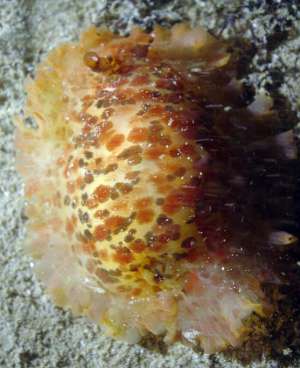
Dear Bill,
During my recent stay in Senegal I found several dendrodorids. Both adults and juveniles. All of them were found in only one site. I will begin with the largest animal. My best guess for this one would be Dendrodoris grandiflora, because of its long gills and the lack of any yellow border. Could you confirm this ID, please? This guy was found during night dive.
Date: June 02, 2003
Location: Dakar, Senegal, Eastern Atlantic
Site: Terou baye Sogui
Depth: 2m
Size: 75-80mm
Photos: Marina Poddubetskaia - Nembro website
[See other messages for photos of juveniles and subadults]
Best wishes,
Marina.
nembro@nembro.info
Poddubetskaia, M., 2003 (Jul 6) Adult Dendrodoris senegalensis from Senegal. [Message in] Sea Slug Forum. Australian Museum, Sydney. Available from http://www.seaslugforum.net/find/10358Dear Marina,
Thanks for these interesting photos. As I discuss in a separate message, I would identify this as Dendrodoris senegalensis. The photos in your other two messages illustrate how colour changes in this species from the red in juveniles to mottled red and brown in adults.
Best wishes,
Bill Rudman
Dendrodoris senegalensis - subadults
July 6, 2003
From: Marina Poddubetskaia
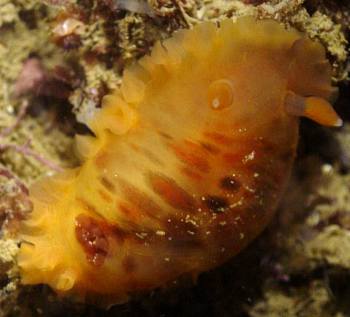
Dear Bill,
Here are some middle-sized dendrodorids and I think they belong to the same species as the adult sent in my previous message. The animal on the first photo has the same colour spots as the adult. I remember, all of them had relatively long gills, even if it can't always be seen in photos.
Dakar, Senegal, Eastern Atlantic. Site: Terou baye Sogui. Depth: 4m. June 02, 2003. Size: Upper Right: 30mm., Lower Right:30-35mm
Photos: Marina Poddubetskaia - Nembro website
[See other messages for photos of juveniles and adults]
Best wishes,
Marina.
nembro@nembro.info
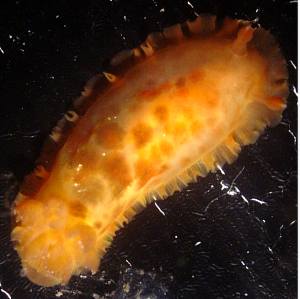
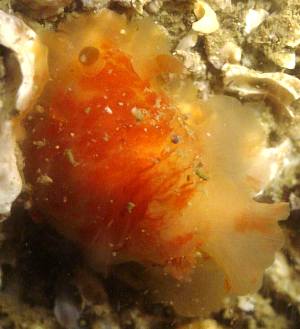
Dear Marina,
I am sure the upper right/lower left animal is Dendrodoris senegalensis, as you suggest. I am not so sure of the lower right animal, but I guess its most likely to be the same species.
Best wishes,
Bill Rudman
